Unit 5 Languages Around the World Listening and speaking课件(共14张,内嵌音频)人教版必修第一册
文档属性
| 名称 | Unit 5 Languages Around the World Listening and speaking课件(共14张,内嵌音频)人教版必修第一册 |  | |
| 格式 | pptx | ||
| 文件大小 | 40.8MB | ||
| 资源类型 | 教案 | ||
| 版本资源 | 人教版(2019) | ||
| 科目 | 英语 | ||
| 更新时间 | 2025-02-27 19:08:43 | ||
图片预览

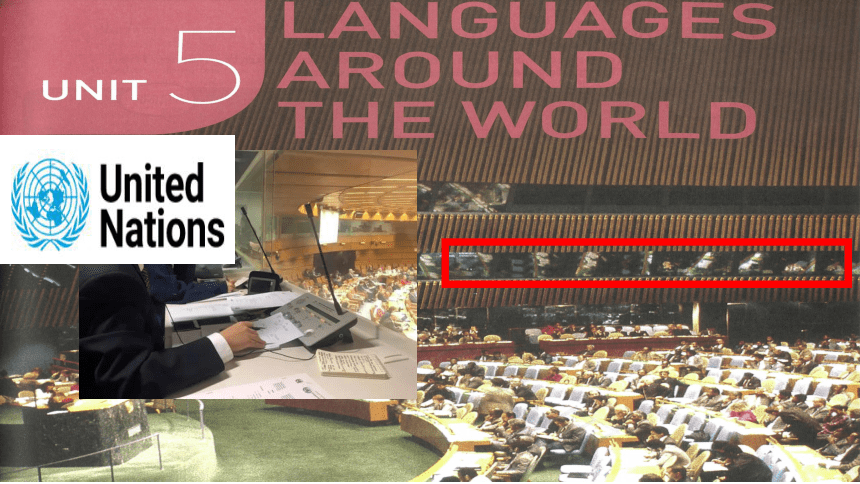
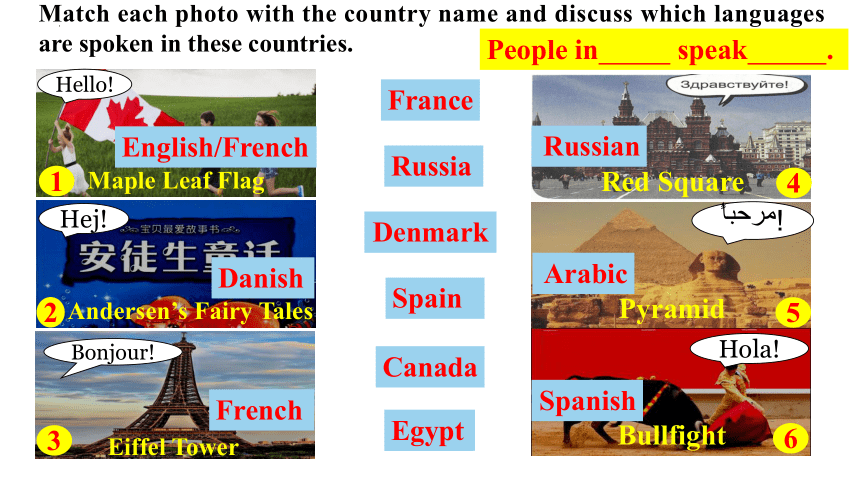
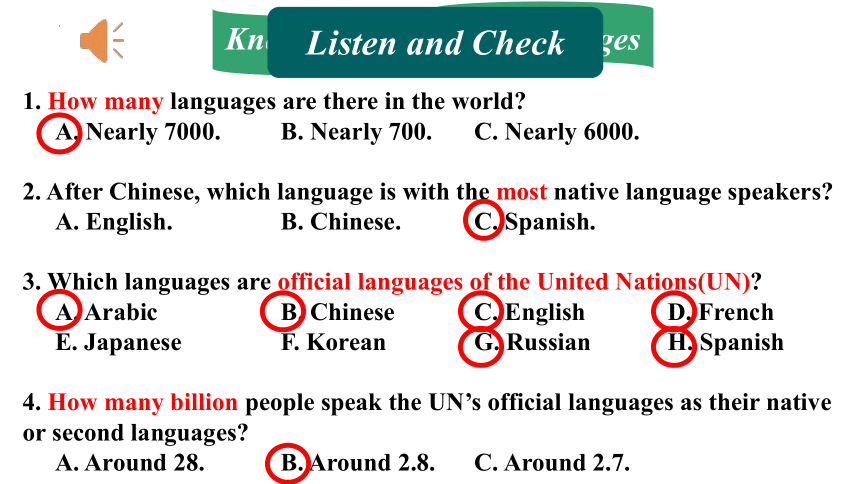
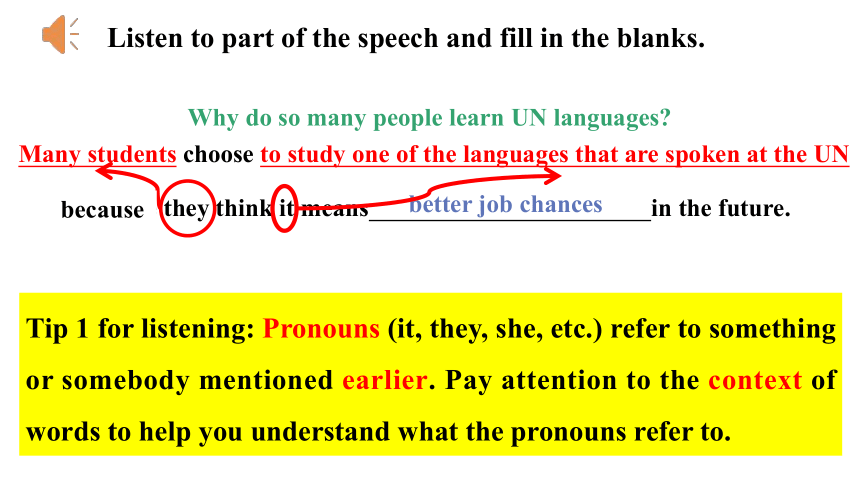
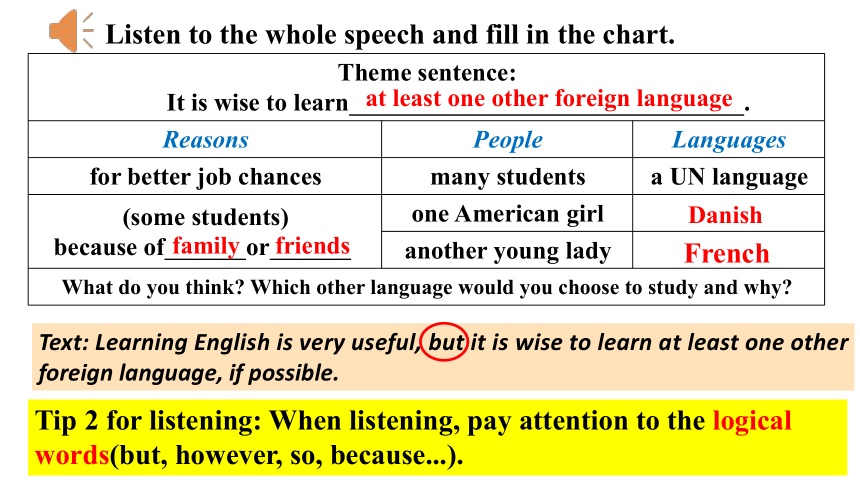
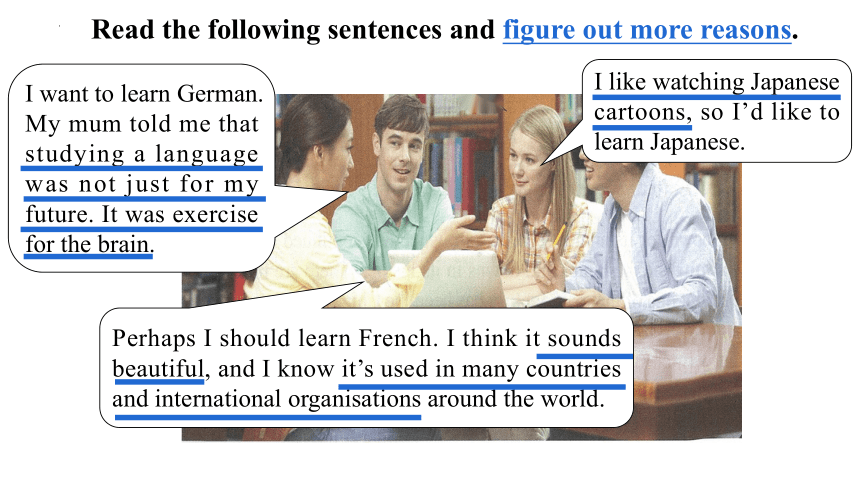
文档简介
(共14张PPT)
Book 1 Unit 5 Languages Around the World
Listening and Speaking--
Explore languages around the world
Match each photo with the country name and discuss which languages are spoken in these countries.
France
Russia
Denmark
Spain
Canada
Egypt
English/French
Danish
French
Russian
Arabic
Spanish
Maple Leaf Flag
Eiffel Tower
Red Square
Bullfight
Pyramid
!
Andersen’s Fairy Tales
Hej!
Hello!
Hola!
Bonjour!
1
2
3
4
5
6
People in speak .
1. How many languages are there in the world
A. Nearly 7000. B. Nearly 700. C. Nearly 6000.
2. After Chinese, which language is with the most native language speakers
A. English. B. Chinese. C. Spanish.
3. Which languages are official languages of the United Nations(UN)
A. Arabic B. Chinese C. English D. French
E. Japanese F. Korean G. Russian H. Spanish
4. How many billion people speak the UN’s official languages as their native or second languages
A. Around 28. B. Around 2.8. C. Around 2.7.
Knowledge Quiz on Languages
Listen and Check
Because they think it means in the future.
Tip 1 for listening: Pronouns (it, they, she, etc.) refer to something or somebody mentioned earlier. Pay attention to the context of words to help you understand what the pronouns refer to.
better job chances
Listen to part of the speech and fill in the blanks.
Many students choose to study one of the languages that are spoken at the UN
Why do so many people learn UN languages
because
Listen to the whole speech and fill in the chart.
Text: Learning English is very useful, but it is wise to learn at least one other foreign language, if possible.
Theme sentence: It is wise to learn . Reasons People Languages
for better job chances many students a UN language
(some students) because of or . one American girl
another young lady
What do you think Which other language would you choose to study and why at least one other foreign language
family
friends
Danish
French
Tip 2 for listening: When listening, pay attention to the logical words(but, however, so, because...).
I like watching Japanese cartoons, so I’d like to learn Japanese.
Perhaps I should learn French. I think it sounds beautiful, and I know it’s used in many countries and international organisations around the world.
Read the following sentences and figure out more reasons.
I want to learn German. My mum told me that studying a language was not just for my future. It was exercise for the brain.
Discussing: Which foreign language would you like to choose Why
EXAMPLE:A: What language do you want to study B: I want to study... I think.../Because...
Group members Languages Reasons
Theme sentence: It is wise to learn at least one other foreign language. Reasons Students Languages
for better job chances many people a UN language
(some students) because of family or friends one American girl Danish
another young lady French
What do you think Which other language would you choose to study and why 1.
A. Topic sentences
B. Supporting details or examples
C. Theme sentence
2. .
Structure of a speech
Tip for speaking: Make a speech in an organized way.
3. .
Theme sentence
Topic sentences
Supporting details or examples
4. Ending(question, slogan, saying...)
Speaking: Imagine you are a volunteer at Confucius Institute, and you are required to make a speech to attract foreigners to learn Chinese.
Good morning, ladies and gentlemen! I feel greatly honored to give a speech to you.
Part 1: (Theme sentence)
Part 2&3:
(Reason 1 + supporting details or examples)
(Reason 2 + supporting details or examples)
(Reason 3 + supporting details or examples)
...
Part 4: (Ending: question, slogan, saying...)
Checklist 1. Does the speaker make the speech in an organized way Yes.( ) No.( )
2. Does the speaker give convincing reasons to attract listeners Yes.( ) No.( )
Chinese has the most native speakers in the world.
Chinese will be the most widely-accepted language in the future.
Make a video to attract foreigners to learn Chinese and post it on TikTok. In your video:
you should give a speech;
you should add pictures with Chinese features.
Homework
You can refer to the reading materials(P62, 68, 96) and the video(P70) in this unit to support your speech.
Thank you.
Book 1 Unit 5 Languages Around the World
Listening and Speaking--
Explore languages around the world
Match each photo with the country name and discuss which languages are spoken in these countries.
France
Russia
Denmark
Spain
Canada
Egypt
English/French
Danish
French
Russian
Arabic
Spanish
Maple Leaf Flag
Eiffel Tower
Red Square
Bullfight
Pyramid
!
Andersen’s Fairy Tales
Hej!
Hello!
Hola!
Bonjour!
1
2
3
4
5
6
People in speak .
1. How many languages are there in the world
A. Nearly 7000. B. Nearly 700. C. Nearly 6000.
2. After Chinese, which language is with the most native language speakers
A. English. B. Chinese. C. Spanish.
3. Which languages are official languages of the United Nations(UN)
A. Arabic B. Chinese C. English D. French
E. Japanese F. Korean G. Russian H. Spanish
4. How many billion people speak the UN’s official languages as their native or second languages
A. Around 28. B. Around 2.8. C. Around 2.7.
Knowledge Quiz on Languages
Listen and Check
Because they think it means in the future.
Tip 1 for listening: Pronouns (it, they, she, etc.) refer to something or somebody mentioned earlier. Pay attention to the context of words to help you understand what the pronouns refer to.
better job chances
Listen to part of the speech and fill in the blanks.
Many students choose to study one of the languages that are spoken at the UN
Why do so many people learn UN languages
because
Listen to the whole speech and fill in the chart.
Text: Learning English is very useful, but it is wise to learn at least one other foreign language, if possible.
Theme sentence: It is wise to learn . Reasons People Languages
for better job chances many students a UN language
(some students) because of or . one American girl
another young lady
What do you think Which other language would you choose to study and why at least one other foreign language
family
friends
Danish
French
Tip 2 for listening: When listening, pay attention to the logical words(but, however, so, because...).
I like watching Japanese cartoons, so I’d like to learn Japanese.
Perhaps I should learn French. I think it sounds beautiful, and I know it’s used in many countries and international organisations around the world.
Read the following sentences and figure out more reasons.
I want to learn German. My mum told me that studying a language was not just for my future. It was exercise for the brain.
Discussing: Which foreign language would you like to choose Why
EXAMPLE:A: What language do you want to study B: I want to study... I think.../Because...
Group members Languages Reasons
Theme sentence: It is wise to learn at least one other foreign language. Reasons Students Languages
for better job chances many people a UN language
(some students) because of family or friends one American girl Danish
another young lady French
What do you think Which other language would you choose to study and why 1.
A. Topic sentences
B. Supporting details or examples
C. Theme sentence
2. .
Structure of a speech
Tip for speaking: Make a speech in an organized way.
3. .
Theme sentence
Topic sentences
Supporting details or examples
4. Ending(question, slogan, saying...)
Speaking: Imagine you are a volunteer at Confucius Institute, and you are required to make a speech to attract foreigners to learn Chinese.
Good morning, ladies and gentlemen! I feel greatly honored to give a speech to you.
Part 1: (Theme sentence)
Part 2&3:
(Reason 1 + supporting details or examples)
(Reason 2 + supporting details or examples)
(Reason 3 + supporting details or examples)
...
Part 4: (Ending: question, slogan, saying...)
Checklist 1. Does the speaker make the speech in an organized way Yes.( ) No.( )
2. Does the speaker give convincing reasons to attract listeners Yes.( ) No.( )
Chinese has the most native speakers in the world.
Chinese will be the most widely-accepted language in the future.
Make a video to attract foreigners to learn Chinese and post it on TikTok. In your video:
you should give a speech;
you should add pictures with Chinese features.
Homework
You can refer to the reading materials(P62, 68, 96) and the video(P70) in this unit to support your speech.
Thank you.
